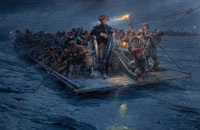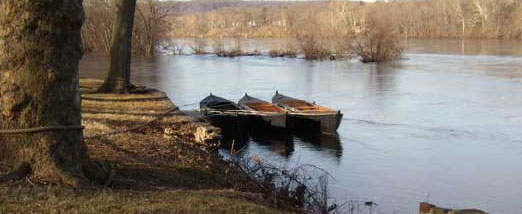
More accurate? Really?
On Christmas Day in 1776, George Washington led what was left of his army across the Delaware River in the middle of a blizzard to attack a Hessian outpost in Trenton, NJ. In one bold stroke, he turned almost certain defeat into at the least the promise of eventual victory. Washington’s crossing was immortalized in the painting, Washington Crossing the Delaware, by Emanuel Leutze in 1851. Everyone agrees that while Emanuel Leutze’s painting is dramatic, it has a number of historical inaccuracies, including the width of the river, the time of day, the weather and the design of the boats used in the crossing.
The New York Times recently featured an article, Crossing the Delaware, More Accurately, describing the work of modern painter, Mort Künstler, who has painted what he claims is a more accurate representation of Washington making the crossing. His painting shows Washington on a flat bottomed ferry connected to both shores by a rope cable. While I make no claim to expertise on Washington’s crossing, it looks to me that Künstler’s version ignores the historical record just as Emanuel Leutze’s painting does.
The problem is that most historians think that the American crossing of the Delaware used Durham boats, large flat-bottomed boats which hauled cargo such as ore, pig-iron, timber, and produce from upcountry mines, forests and farms down the Delaware River to Philadelphia’s thriving markets and port. Robert Durham, an engineer at the Durham Iron Works in Reiglesville, Pennsylvania, reputedly designed a prototype for these large cargo boats as early as 1757. Washington wrote to Governor Livingston of New Jersey, directing him to secure “Boats and Craft, all along the Delaware side…particularly the Durham Boats” for his anticipated crossing.
While it is possible that a flat bottom ferry was used by Washington in the crossing, there seems to be little historical evidence for it. (If I am showing the extent of my ignorance here I would be happy to be corrected.) A flat bottomed ferry would be far more efficient for transporting artillery and horses, while the Durham boats would be fine for transporting troops. Nevertheless it appears that the same boats were used for both purposes. Lt. Col. John Fitzgerald wrote in his diary, “The troops are over, and the boats have gone back for the artillery. We are three hours behind the set time.” Washington’s army transported 18 field pieces across the Delaware. (The American army relied far more heavily than the British on artillery, using cannon as a “force multiplier,” to use modern terminology.)
It also strikes me as a bit unlikely that a flat bottom ferry with a cable running across the river could have been set up and rigged in the darkness during a blizzard across an ice laden river. Whether flat bottom ferries were used significantly in the crossing is unclear. Several sources describe cannon being secured on Durham boats, while David Hackett Fischer’s Washington’s Crossing suggests that barges were used for the artillery and horses.
It appears unlikely, however, that Washington himself traveled by flat bottomed ferry. By tradition, he was rowed across with the troops in a boat under the command of Captain William Blackler, arriving on the New Jersey river bank prior to the artillery. It seems most probable that Washington, like most of the troops, traveled by Durham boat. One complaint about Leutze’s painting is that it shows Washington standing in the boat. The depth of the Durham boat effectively requires that everyone aboard stand, though the gunnel would be waist high, unlike the boats shown in Leutze’s painting.
The Washington Crossing Historical Park has several replica Durham boats on display which it uses for yearly re-enactments of the famous crossing.

Durham boats on the Delaware

I agree with Rick Spilman. I don’t believe Washington would have crossed the Delaware on a pontoon craft. Modern painters, like , Mort Künstler, are wrong reviewing Emanuel Leutze 1851 painting of “Washington Crossing the Delaware”.
FIRST : During the French and Indian Wars, the French and the British were moving their armies on batteaux and Durham boats.
In 1757, the French used 300 batteaux on their way to fort William–Henry (Lake George -NY), together with 30 pontoons for the artillery. The pontoons were multihull batteaux.
In 1758, the Batoe Service in Albany constructed 1 500 flat bottom boats for the British army. They became known as Durham boats.
SECOND: It is a fact that Durham boats played an important part in Washington’s Crossing of the Delaware on December 25, 1776. A few days before, Washington had written Governor Livingston of New Jersey, directing him to secure “Boats and Craft, all along the Delaware side…particularly the Durham Boats” for his anticipated crossing.
THIRD: On land army officers always secured the fastest way to move along: on horses. Same for navy officers who used light rowboats. Durham boats used oars and poles, and were fast compared to pontoons, especially in a winter condition where a river is covered with ice.
Washington had a choice between many crafts, including Durham boats and pontoons. He must have made his choice for the fastest way to go across, to maintain contact with his generals, and facing a superior power, to withdraw. It appears that on the Delaware, flat bottom boats were the best crafts available to fit the moment.
Yvan-M. Roy
Lévis, Québec
Pingback: EDA-R : New French Navy Landing Craft | Old Salt Blog – a virtual port of call for all those who love the sea
Pulitzer Prize winner, Joseph Ellis says, “The boats used for the crossing were not as Leutze described. They were high-walled barges akin to the landing craft used for amphibious assults in WWII, and everyone Stood up in them.” I believe I will trust someone who is a recognized detail historical expert like Kunstler and a similiar expert like Ellis.
I personally prefer to trust the original documents which clearly suggest that Durham boats were used extensively in the crossing. Washington’s own orders to assemble boats for the crossing specifically mentioned Durham boats which he notes “are very proper for the purpose” of transporting troops and baggage.
Ellis’ book “His Excellency George Washington” spends two paragraphs on the crossing. David Hackett Fischer’s Pulitzer Prize winning book, “Washington’s Crossing” looks at the crossing in detail and does discuss the use of Durham boats. He suggests that the Durham boats were used for transporting troops and would be useless for transporting cannon and horses. Nevertheless, Lt. Col. John Fitzgerald wrote in his diary, “The troops are over, and the boats have gone back for the artillery.” Lt. Col. Fitzgerald, who participated in the crossing, appears to be suggesting that the same Durham boats were used for both troops and artillery.
Ellis seems to be confused. To my knowledge Leutz never “described” the boats. As an artist, he painted his conception of the crossing taking considerable liberties with geography, time of day and boat design. Also there were no landing craft “akin to the landing craft used for amphibious assults in WWII” in 1776. They simply did not exist. The Durham boats, however, were indeed flat bottomed and “high walled” and could have been referred to as “barges” in an 18th century context. Because the gunnels were so high, everyone did stand up in them. It looks to me that Ellis is describing the Durham boats, whether he realizes it or not. I have great respect for Ellis as a historian. In this case, he just isn’t much of a naval architect.
If they had something as simple as a ferry to get across, surely it would have been noted. I’ve seen period artillery manuals that describe how to load field guns into boats, and it involves taking the tube off the carriage, as well as perhaps the wheels. Definitely an easy task for an experienced gun crew. Amphibious operations were common in the 18th and 19th centuries and batteaux were the preferred transport craft throughout this period. They wouldn’t have needed a flat or ferry to get across with field guns.
Disappointed. I was searching for a Washington Crossing the Delaware
toy boat, and I was given this site. Is it me or is everything made in China? Is nothing sacred anymore?
A letter George Washington sent to Gen. Nathaniel Greene, his quartermaster and No. 2 person, can be seen at the Chapin Library, Williams College, Williamstown, MA. The letter doesn’t say, “I’m heading for the Delaware,” but the timing is right and the request is for Greene to get him Durham boats.
I think that the book 1776 accuratly describes why a flat bottom barge was used and why durham boats would not have been used